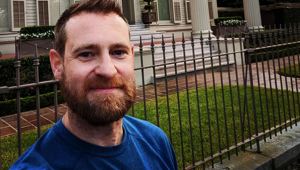“There’s something that’s so enduring about this character,” Andrew Scott says of the classic queer-coded antihero Tom Ripley, “and I think it’s because we have so many questions about him.”
When we heard the actor was tapped to play the eponymous role in a new adaptation of The Talented Mr. Ripley—Patricia Highsmith’s 1955 crime novel about fictional conman Tom Ripley—our first question was: “Oh this is about to be so gay, isn’t it?”
And now that we’ve had a chance to see Ripley, writer-director Steven Zaillian’s gorgeous series that hits Netflix on April 4, we’re pleased to report out prediction was right!
Though not at all in the way we had expected.
Your dose of fabulosi-TEA
Subscribe to our newsletter for your front-row seat to all things entertainment with a sprinkle of everything else queer.
First thing’s first: Tom Ripley is not “gay.” At least, not according to Highsmith herself, who once confusingly asserted that Ripley “appreciates good looks in other men” but couldn’t possibly be gay because he’s married to a woman in her later books and even “makes it in bed with his wife.”
And while Scott might not completely agree with Highsmith’s assessment of her most famous or, rather, infamous character, he’s careful to acknowledge that, when it comes to Ripley’s much-debated queerness, things (ironically) aren’t so black-and-white.
“One of the big things about [Ripley’s] sexuality,” Scott shares with Queerty, “was that I felt quite strongly that I didn’t want to overly diagnose—for want of a better word—his sexuality, or even his nationality, or his age, or his upbringing.”
Much like Highsmith’s first novel, the series tiptoes right up to the line of Ripley’s queerness, though it’s a line that only becomes blurrier the closer you get. Sent to Italy to convince wealthy heir Dickie Greenleaf (played here by Emma‘s Johnny Flynn) to return home to America, Ripley finds himself infatuated with the expat’s lifestyle to the point of obsession, and is perhaps even jealous of Dickie’s girlfriend, Marge Sherwood (Dakota Fanning).
But does he want to be Dickie, or be with him?
Even after their relationship takes a dark turn, Highsmith’s writing avoided easy answers, and that uncertainty became a trademark of the character, a man who never gets any less slippery or elusive—not across her five novels, five different film adaptations, and nearly three-quarters of a century.
Related:
Peak gay villainy: 20 titillating facts about ‘The Talented Mr. Ripley’
Do you know which A-list Oscar winner almost played Ripley instead of Matt Damon?
The Man Of Many Faces
Scott steps into the iconic role after what’s unquestionably been the biggest year of his career thus far, thanks to his award-winning performances in All Of Us Strangers and in the West End production of Vanya. But the 47-year-old Irish actor has been working steadily on stage and screen since the ’90s, notably playing high-profile villains opposite the likes of Sherlock Holmes and James Bond, while also stealing everyone’s hearts as “The Hot Priest” in the Emmy-winning comedy Fleabag.
And while those characters cleanly fall on either side of a moral code, Ripley represented someone who was harder to place—making him all the more enticing to Scott.

“Your first job as an actor is to try and understand the character and not judge them… [and] for that reason, you kind of love them,” Scott reflects. “The big challenge for me in this character was to accept the fact that there’ll be some part of Tom that I’ll never really know—as much as I want to—which made it a kind of lonely place to be.”
But he’s not entirely alone: Over the decades, we’ve seen a number of high-profile performers bring their unique talents to Tom Ripley, from suave French screen idol Alain Delon, to Dennis Hooper, Barry Pepper, and John Malkovich (who, intriguingly, plays a small role in Ripley), to—most famously—Matt Damon, whose 1999 The Talented Mr. Ripley remains the most commercially successful screen adaptation of the series.
Directed by Anthony Minghella, Damon channels his natural movie-star charisma into the conman’s more calculated charms, while also showing us flashes of a wounded humanity not present in Highsmith’s novel. In fact, the film takes a fair number of creative liberties with the source material, like deliberately leaning into the homoerotic undertones of Tom and Dickie’s relationship, and even later giving Tom a tragically ill-fated male partner.
Without spoiling too much, Ripley proves itself to be much more loyal to the book. There is no steamy bathtub chess scene, there’s no potential romance with another man—even mentions of the words “gay” or “queer” are carefully danced around. It’s not so much that this Tom Ripley is “in the closet” as he is completely hidden in the dark.
Related:
From ‘Spartacus’ to ‘Saltburn’: Get squeaky clean with these 9 homoerotic bathtub scenes
Rub a dub dub two guys in a tub!
One Queer Fella
While one might expect a modern interpretation of the material to more overtly address the character’s sexuality (for example, AMC’s take on Anne Rice’s Interview With The Vampire provided a solid model, finally giving us the full-on gay fang-bang we’ve been waiting for), this series is more interested in placing Tom Ripley in the context of a certain place and time. Here, in 1960s Italy, brushing up against the world of the wealthy, he’s an outsider in every sense of the word
In turn, Scott’s Ripley is much more opaque than Damon’s, and that’s by design. Clinging to a social and moral “murkiness” (Scott’s word), his introverted interpretation of this antihero is impossible to take your eyes off of. And while we may not see demonstrations of Ripley’s queerness in a romantic or relational sense, we can recognize how he takes advantage of his otherness to move through the world.
“I think that’s a really interesting part of him, actually,” says Scott of Ripley’s status as an other, and the fluidity therein. “I certainly think that he uses the prejudice of the time for his own gain, because so much of the atmosphere at the time was coded and about secrets and what people say [versus] what they actually might feel.”

Because whether or not Ripley would admit it, others—like the increasingly suspicious Marge—view him as an outsider, and even assume he might be queer. To an extent, that puts a target on his back, but he quickly learns to use it as a shield—or a weapon. When the local authorities come knocking, they seem uncomfortable prying too much into his life, afraid of the truths they might uncover. And Ripley knows it.
In other words, when Ripley finds himself backed into a corner, it’s those very places that people don’t want to go—the questions that “polite” society doesn’t want to ask—that allow him to slip through the cracks. So long as he exists in the shadows, outside of the bounds of a rigid heteronormative world, he can basically get away with, well, you get it.
Related:
Before Stonewall: 9 must-see queer period pieces set in the mid-20th century
“Queer people didn’t just show up at Stonewall—we’ve been around forever.”
Shadowy Figures
As Ripley lures you in, a motif gradually rises to the surface: The work of Italian baroque artist Caravaggio, the turn-of-the-17th-century painter whose distinctive “chiaroscuro” style is both an influence on the series’ stunningly stark look—and on Ripley himself.
It’s no coincidence that Caravaggio, despite being one of the most sought-after artists of his time, was also a volatile man with a serious criminal record. Known to provoke street brawls at random, he made enemies with many dangerous individuals, and is even said to have killed a few of them. His reputation meant he was never able to stay in one place for long. Sound familiar?
Not unlike Ripley, the painter’s sexuality—and the role it might or might not have played in his most incomprehensible behavior—has long been the subject of speculation.

“There are so many things about Caravaggio that Tom finds completely fascinating,” Scott shares excitedly. “I think it’s a really amazing touch that he has a sort of kinship with this person from so many years ago. It’s so interesting in relation to what we want to know about people, and how we identify people.”
In drawing the parallels between these two men, Ripley forces us to question our own biases—the labels we might prescribe to others in an effort to make sense of the world.
“The great achievement of this [story,] I think, is that we’re rooting for somebody who morally isn’t necessarily somebody we should be rooting for,” the actor adds. “We want the audience to feel like what it’s like to be Tom Ripley, rather than what it’s like to be a victim of Tom Ripley. And for that reason, we have to look at the bits of ourselves that are Tom Ripley-esque.”
“I’m not saying that we’re all murderous,” Scott continues, “but there’s certainly stuff within us that we don’t have access to. And there’s a blankness that you go, ‘I don’t understand that about myself.'”
So, is Tom Ripley gay? Straight? Is he a villain? An antihero? Is he someone we should fear, or pity? Is it so wrong that we might walk away from Ripley—if not empathizing with him—at least understanding where he’s coming from?
As Andrew Scott sees it, “[to] reduce the character by answering too many of those questions is actually a crime in itself.”
Ripley is now streaming exclusively on Netflix.
Related:
PHOTOS: Just an appreciation post about Andrew Scott’s low-key bicep game
Andrew Scott has been teasing us with his stealth bicep game this whole time!

























jp47
I think Andrew Scott is an extremely talented actor, but he’s about twenty-five years too old for the part. This is the first Ripley book and he’s supposed to be a young man, that’s where I prefer the Matt Damon film, even though it takes liberties with plot points of the book. Damon, and the other actors in the film, were more close to the correct age for believability. As for whether Ripley was gay or not, my thinking is he was sexually inclined toward men, but hated that part of himself, so he felt if the objects of his desire were dead and he eventually married a woman, he was not gay.
flymeorion
Totally agree.
OzJay
I think the question of Ripley’s sexuality is down to Patricia Highsmith’s own notions of sexuality, which were a product of her times and her own tortured sexuality. I think she was more adept at writing about sociopaths than about gay men.
BrokebackBob
Absolutely agree 100%. This version is completely derivative and the definitive version is the Matt Damon Jude Law version, case closed.
Walking the Dog
But for anyone who has not read the books, Andrew Scott’s age should not be a problem.
Donston
It’s getting passable enough (though not great) reviews. I just don’t think a black and white miniseries retelling of this story is necessary. I’ll check it out eventually though. While how many “queer obsessed with/in love with straight-presenting person who never indulges any of their desires/affections” thrillers do we need? New ideas needed.
Kangol2
Not a fan of remakes like this, nor a fan of Scott (too old for the role) playing Ripley, but I’ll give the first episode a try. I agree with Donston that it’s time for new ideas. There are tons of options out there!
1967Man
I don’t know how gay it is, but I know how boring it is.
Kangol2
Sounds like the opposite of an endorsement.